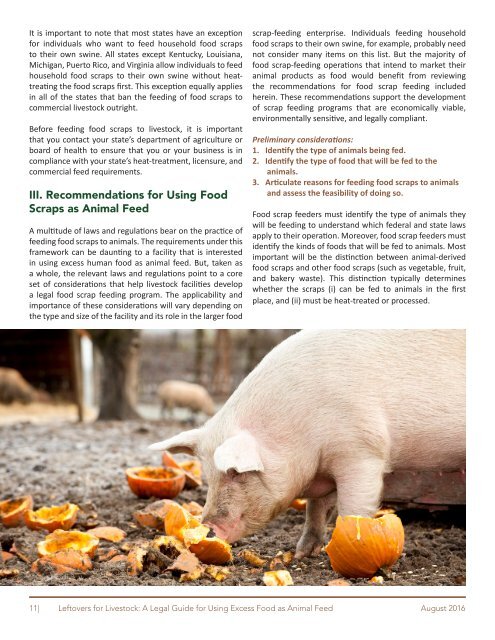LEFTOVERS FOR LIVESTOCK
Leftovers-for-Livestock_A-Legal-Guide_August-2016
Leftovers-for-Livestock_A-Legal-Guide_August-2016
Create successful ePaper yourself
Turn your PDF publications into a flip-book with our unique Google optimized e-Paper software.
It is important to note that most states have an exception<br />
for individuals who want to feed household food scraps<br />
to their own swine. All states except Kentucky, Louisiana,<br />
Michigan, Puerto Rico, and Virginia allow individuals to feed<br />
household food scraps to their own swine without heattreating<br />
the food scraps first. This exception equally applies<br />
in all of the states that ban the feeding of food scraps to<br />
commercial livestock outright.<br />
Before feeding food scraps to livestock, it is important<br />
that you contact your state’s department of agriculture or<br />
board of health to ensure that you or your business is in<br />
compliance with your state’s heat-treatment, licensure, and<br />
commercial feed requirements.<br />
III. Recommendations for Using Food<br />
Scraps as Animal Feed<br />
A multitude of laws and regulations bear on the practice of<br />
feeding food scraps to animals. The requirements under this<br />
framework can be daunting to a facility that is interested<br />
in using excess human food as animal feed. But, taken as<br />
a whole, the relevant laws and regulations point to a core<br />
set of considerations that help livestock facilities develop<br />
a legal food scrap feeding program. The applicability and<br />
importance of these considerations will vary depending on<br />
the type and size of the facility and its role in the larger food<br />
scrap-feeding enterprise. Individuals feeding household<br />
food scraps to their own swine, for example, probably need<br />
not consider many items on this list. But the majority of<br />
food scrap-feeding operations that intend to market their<br />
animal products as food would benefit from reviewing<br />
the recommendations for food scrap feeding included<br />
herein. These recommendations support the development<br />
of scrap feeding programs that are economically viable,<br />
environmentally sensitive, and legally compliant.<br />
Preliminary considerations:<br />
1. Identify the type of animals being fed.<br />
2. Identify the type of food that will be fed to the<br />
animals.<br />
3. Articulate reasons for feeding food scraps to animals<br />
and assess the feasibility of doing so.<br />
Food scrap feeders must identify the type of animals they<br />
will be feeding to understand which federal and state laws<br />
apply to their operation. Moreover, food scrap feeders must<br />
identify the kinds of foods that will be fed to animals. Most<br />
important will be the distinction between animal-derived<br />
food scraps and other food scraps (such as vegetable, fruit,<br />
and bakery waste). This distinction typically determines<br />
whether the scraps (i) can be fed to animals in the first<br />
place, and (ii) must be heat-treated or processed.<br />
11| Leftovers for Livestock: A Legal Guide for Using Excess Food as Animal Feed August 2016


